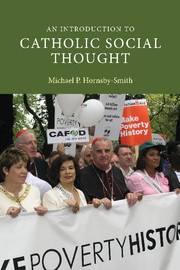Book contents
- Frontmatter
- Contents
- List of tables and figure
- Acknowledgements
- Dedication
- List of abbreviations and acronyms
- PART I SOCIAL REALITY AND SOCIAL ANALYSIS
- PART II THEOLOGICAL RESOURCES
- PART III JUSTICE ISSUES
- 6 Human rights
- 7 The family
- 8 Economic life
- 9 Social exclusion
- 10 Authentic development
- 11 War and peace
- PART IV ACTION RESPONSES
- Appendix: Selected campaigning organizations
- References
- Index
10 - Authentic development
Published online by Cambridge University Press: 14 January 2010
- Frontmatter
- Contents
- List of tables and figure
- Acknowledgements
- Dedication
- List of abbreviations and acronyms
- PART I SOCIAL REALITY AND SOCIAL ANALYSIS
- PART II THEOLOGICAL RESOURCES
- PART III JUSTICE ISSUES
- 6 Human rights
- 7 The family
- 8 Economic life
- 9 Social exclusion
- 10 Authentic development
- 11 War and peace
- PART IV ACTION RESPONSES
- Appendix: Selected campaigning organizations
- References
- Index
Summary
INTERNATIONAL INEQUALITIES AND INJUSTICES
The fifth area of concern is that of international distributive justice and authentic development. ‘The richest 5 per cent of the world's people receive 114 times the income of the poorest 5 per cent. The richest 1 per cent receive as much as the poorest 57 per cent’. There is evidence that the gap between rich and poor countries has widened in recent years. Whereas the average income per head in the richest country today is around 400 times that in the poorest country, 250 years ago the ratio was around 5:1. Billions of people in developing countries cannot satisfy their elementary needs. They are undernourished and have no access to drinkable water, sanitary and medical services, or schooling. The poorest fifth of the world's population have limited access to credit, capital and technology. Real incomes in the ‘post-industrial’ world rose at 2.4 per cent a year between 1965 and 1999 compared to 1.6 per cent in the world as a whole. The same countries also consumed half of the world's output of commercial energy and generated half of all carbon dioxide emissions although their proportion of the world's population declined from 32 per cent in 1950 to only 19 per cent today.
While it is true that for decades missionary orders addressed the educational and health needs of many of the former colonial territories, in many ways it is only in recent years that attention has shifted from the amelioration of need to the search for understanding of the root causes of persistent needs and injustices, now regarded as social and structural sins, and to social action such as political advocacy to change unjust structures.
- Type
- Chapter
- Information
- An Introduction to Catholic Social Thought , pp. 241 - 281Publisher: Cambridge University PressPrint publication year: 2006

